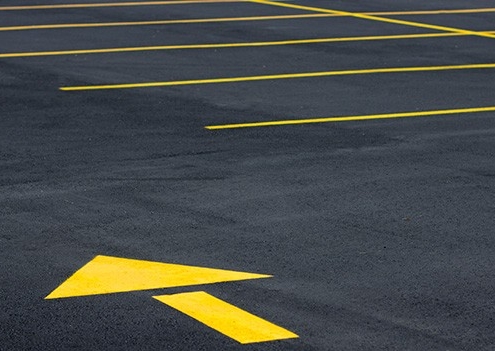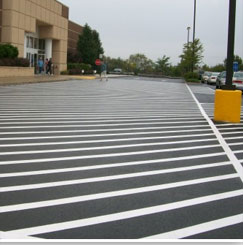Recognizing the Relevance of Roadway Paint in Urban Infrastructure Development
The duty of roadway painting in metropolitan facilities growth prolongs beyond plain appearances, functioning as a fundamental element in boosting security and enhancing traffic flow. Reliable road markings not only give important support for both motorists and pedestrians but additionally contribute to the general functionality of city spaces. As cities progress, the integration of innovative layouts into road paint can significantly influence area characteristics and ecological sustainability. The question continues to be: exactly how can urban coordinators stabilize these diverse goals to create engaging and absolutely effective roads?
Safety Enhancements Through Road Markings
Frequently ignored in urban infrastructure advancement, road markings play an important duty in enhancing safety for both drivers and pedestrians. These markings work as crucial aesthetic cues that lead automobile movement and establish order on roadways. Properly designed and maintained road markings connect critical information, such as lane borders, pedestrian crossings, and quit lines, properly lowering the chance of mishaps.
The exposure and clearness of road markings are critical, particularly in adverse climate problems. High-contrast materials and reflective paints aid guarantee that markings remain noticeable in the evening and throughout rainy problems, therefore enhancing safety end results. In addition, the application of standardized symbols, such as arrowheads and pedestrian symbols, cultivates much better understanding among roadway users, advertising conformity with traffic laws.
Along with their useful aspects, roadway markings contribute dramatically to the general visual of urban settings. Well-executed road paint improves the aesthetic charm of streetscapes while simultaneously enhancing the significance of roadway security. As cities remain to develop and grow, focusing on the top quality and maintenance of road markings is important in fostering a effective and secure transport system for all users.
Effect On Traffic Flow
Maximizing web traffic flow is dramatically influenced by the critical implementation of roadway markings. Correctly designed and maintained road markings provide vital assistance for motorists, assisting in smoother navigating via numerous traffic situations. By clearly delineating lanes, indicating turning points, and marking junctions, road markings help in reducing complication and avoid crashes, eventually enhancing overall traffic performance.
Additionally, road markings play a critical duty in regulating lorry rates. The use of lane decrease markings and speed up limitation indications can influence driver actions, urging adherence to secure driving practices. This, in turn, alleviates blockage and advertises a much more fluid activity of cars.
In addition, well-placed roadway markings can boost the effectiveness of traffic signals and indications. By making sure that these elements are aesthetically strengthened with appropriate pavement markings, motorists obtain constant and meaningful details, enabling more informed decision-making.
In urban environments, where website traffic thickness is high, the assimilation of sophisticated road paint methods, such as reflective and thermoplastic products, can better boost exposure under different weather conditions. In summary, efficient road markings are essential for optimizing web traffic circulation, adding to safer and a lot more efficient city transport systems.
Supporting Pedestrian Navigation
Efficient roadway markings are essential for supporting pedestrian navigating, particularly in city locations where foot traffic is significant - Parking lot line painting. Clear, well-defined crosswalks, directional arrowheads, and pedestrian symbols improve visibility and overview pedestrians safely across highways. These markings educate pedestrians of their right of way, decreasing the likelihood of crashes and boosting overall safety
Furthermore, reliable road paint can mark various zones within the city atmosphere, such as dividing pedestrian courses from car lanes. This delineation fosters a more secure strolling experience, motivating increased foot traffic and promoting city vitality. Markings that assign pedestrian-only areas or shared rooms even more boost navigation by making clear where pedestrians can safely go across without disturbance from cars.

View Line painting Abbotsford in a full screen map
Aesthetic Payments to Urban Layout
The aesthetic contributions of roadway painting substantially improve metropolitan design, changing regular streets into visually involving rooms. Thoughtfully created highway markings and dynamic colors create an aesthetic narrative that can mirror the identification of an area. Imaginative crosswalks, as an example, not only offer their practical function however likewise function as public art setups, encouraging area communication and pride.
Moreover, the critical use shade can influence perceptions of safety and availability. Brightly repainted bike lanes and pedestrian zones can mark areas, making them extra enticing and encouraging their usage. This, subsequently, cultivates a feeling of neighborhood by promoting active transportation modes, such as right here walking and cycling.
Additionally, roadway paint plays a critical role in metropolitan revitalization efforts. Eventually, the visual payments of roadway painting are vital for the development of dynamic, comfortable city spaces that reverberate with the area's character and desires.
Ecological Factors To Consider in Roadway Painting

To mitigate these problems, the adoption of environment-friendly alternatives is necessary. Water-based paints and those made from lasting products help in reducing VOC discharges and improve overall environmental effect. Furthermore, reflective and polycarbonate markings can boost visibility while decreasing the need for frequent repainting, thus lowering material consumption in time.
Additionally, roadway painting can be integrated with metropolitan eco-friendly efforts, such as making use of absorptive materials that enable rain to penetrate, consequently reducing drainage and advertising groundwater recharge. In summary, while roadway paint is critical for city functionality, it is vital that ecological factors to consider guide material choice and application methods to make certain lasting metropolitan growth.
Verdict
In final thought, road paint plays a critical role in city facilities growth by improving safety and security, enhancing web traffic circulation, and supporting pedestrian navigating. Additionally, focus to environmental factors to consider in road painting contributes to sustainable city growth.
